Abstract
Oroxylum indicum(Linn.) Vent , the plant used in this study is one among the group of ten drugs named Dasamoola, widely used in Ayurvedic system of medicine. The officinal part of this plant, the root bark is often adulterated with the stem of the plant. Hence this comparative study of root and stem of this plant becomes highly significant.
The Physico-chemical parameters, Thin Layer Chromatography and High Performance Thin Layer Chromatography studies of stem and root were carried out in this study separately. The TLC studies of three different fractions were isolated - (1) Lipids, fats and waxes (2) Glycosides, Terpenoids and Phenols (3) Alkaloids TLC studies showed that the phytochemicals isolated from root and stem separately are different from each other, thus helping to distinguish the part used.
The review of Ayurvedic classical literature also reveals that the therapeutic actions of stem and root are different. The antibacterial activity of alcoholic extracts of stem and root were carried out separately using agar well diffusion method and found that the stem extract has more antibacterial activity especially against organisms causing diarrhea than root extract. This further validates therapeutic indications mentioned in Ayurveda.
Introduction:
Plant based drugs for centuries have been an important source of precursors used in a variety of industries, including foods and pharmaceuticals. India is considered to be a rich emporium of medicinal plants, used for preventive and curative properties. Oroxylum indicum is one such plant, used in several Ayurvedic preparations and is one of the ingredients of Dasamoolam, officinal part being root bark.
Commercialization of Ayurvedic products have led to a shortage of raw materials, which in turn led to adulteration and substitution, and more often, the root of a plant gets substituted with its stem. It is in this context that the comparative study of stem and root of the plant becomes significant. The authenticity, quality and purity of a crude drug is established by fixing some standards, which include physico-chemical parameters, nature of chemical constituents and microbial chemistry. Use of indigenous systems of medicine is encouraged by the governments.
In Ayurvedic classical literature, Oroxylum indicum (Syonaka) is classified under the following groups of drugs:-
Sothahara, Sita prasamana, Anuvasanopaga, Pureeshasangrahaneeya (Charaka)
Rodhradhi,Viratarvadi,Brihat panchamoolam(Susrutha) Rodhradhi, Viratarvadi, Brihat panchamoolam (Vaghbata)
Therapeutic properties
Rasa-Thiktha (bitter), Kashaya (astringent)
Guna-Laghu (light), Ruksha(dry)
Virya-Seetha (cold)
Vipaka-Katu (pungent)
Karma-Kapha Vata hara, Dipana, Grahi
Indications-Amavata, Atisara, Aruchi, Kasa, Vastivikara, Vataroga, Sotha
DOSE - 5-10 g. in powder form.
25-50 g. in decoction.
Important formulations
Brahma rasayana, Chyavanaprasa, Misraka sneha, Dasamoola rasayana, Syonaka thailam, Pashanabhedadhi gritham, Dasamoola hareethaki, Sidharthakadhi agadam, Mahat-panchamoola thailam, Sathahwadhi dhooma, Pushyanuga choornam, Agastya hareethaki, Narayana taila, Masha tailam, Dasamoolarishta, Dasamoola kwatham, Veeratharvadhi kashayam, Syonaka putapakam, Amritarishta, Dantyadyarishta, Dhanvantara Ghrta.
Both the stem and root are useful parts in many formulations as per Ayurvedic classics, stem is mentioned only in certain cases as anti-diarrheals.
Following are the properties and uses of this drug as mentioned in the classics and Ayurvedic Pharmacopoeia of India. (Table. 1)
Table 1.
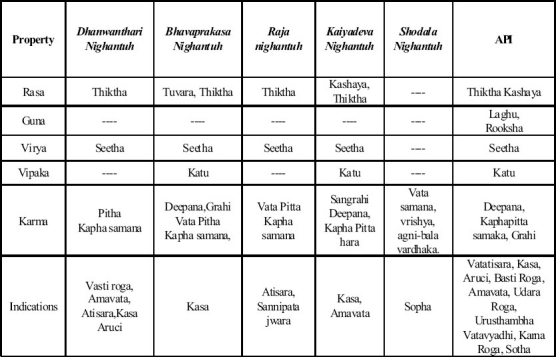
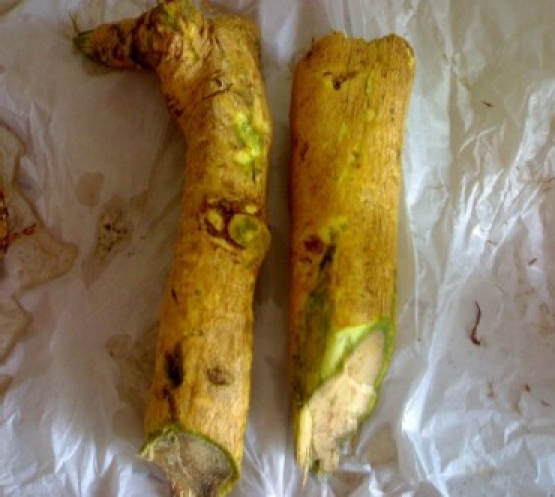
Oroxylum indicum-root
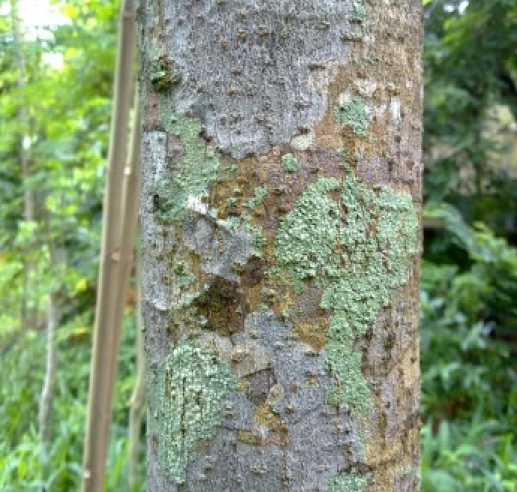
Oroxylum indicum-stem
Materials and Methods
The drug- Oroxylum indicum
Vernacular name-Palakappayyani(Malayalam)
Genuine samples was collected and further identified by an expert. Root and stem were separately cleaned and dried in shade. They were then chopped and powdered and used for the study. All chemicals used were of AR or HPTLC grade.
Physico-chemical parameters were done as per Ayurvedic Pharmacopoeia of India.
Separation of chemical constituents was done using solvent extraction as per the scheme given below.
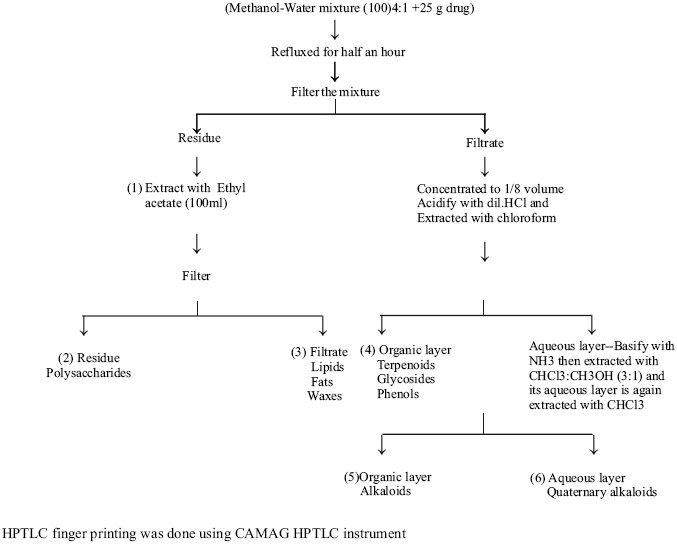
Results and discussion
Physico chemical parameters-Table 1
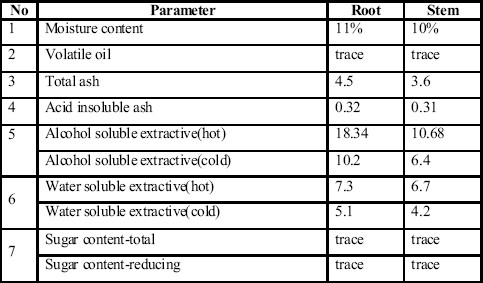
Physico chemical parameters for both the stem and root are almost the same except for the alcohol soluble extractive. Root gives 18% and for stem 10%.
Isolation of various constituents
Phenols and alkaloids were isolated using general method for isolation given in materials and methods. Organic layer on testing for terpenoids, phenols and glycosides showed the presence of only phenols (blue colour with neutral ferric chloride). Both the stem and root gave the test for phenols. Tannins were detected in the hot aqueous extract of both the stem and root.
TLC study of different extracts of stem and root were carried out with a view to distinguish between them.
TLC study of different fractions separated from stem and root
Different fractions separated (1) Lipids, fats and waxes. (2) Glycosides, Terpenoids and Phenols. (3)Alkaloids
(1) Lipids, fats and waxes.
Solvent system-Benzene-Acetone 9:1
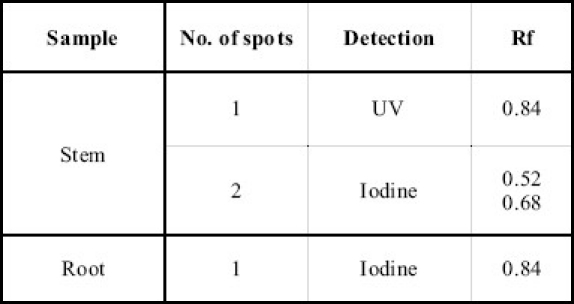
Stem gave one spot Rf 0.84 in UV, whereas root did not give any spot in UV. In Iodine stem gave 2 spots Rf 0.52 and 0.68 and root gave one spot of Rf 0.84. i.e., the three compounds were separated from stem lipids, fats and waxes, and only one compound from root. Also the compounds isolated are different.
Toluene-Ethyl acetate 7:3
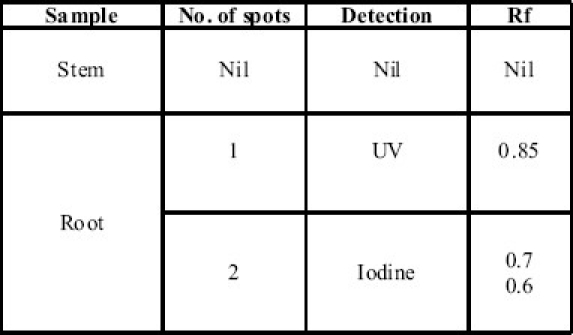
In this solvent system, three compounds were separated from root, one spot of Rf 0.85 in UV, and 2 spots of Rf 0.7, 0.6 in Iodine.
(2) TLC study of phenols separated
Solvent system--Benzene-Acetone 9:1
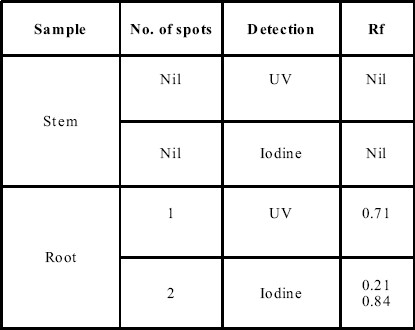
Phenolic compounds of stem could not be detected in this solvent system where as that of root was detected. Three compounds were separated with Rf 0.71 in UV, and 0.21 and 0.84 in Iodine indicating that the phenols present in the root are not present in stem.
Toluene-Ethyl acetate 7:3
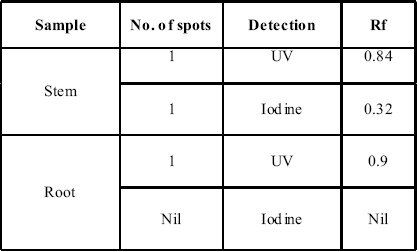
In this solvent system, two phenolic compounds could be separated with Rf 0.32, in Iodine and 0.84 in UV and one compound with Rf 0.9 in root also indicating that phenolic compounds in root and stem are different.
(3)TLC study of alkaloids
Solvent system--Dioxan-Ammonia 9:1

Alkaloids separated were subjected to TLC in solvent system Dioxan-Ammonia 9:1. Two different alkaloids were separated from the stem and root, as evidenced by different Rf values. Stem gave one brown fluorescent spot of Rf 0.9, whereas root gave one spot of Rf 0.27.
From the above results, it can be seen that TLC studies of different fractions can be used to distinguish stem from root.
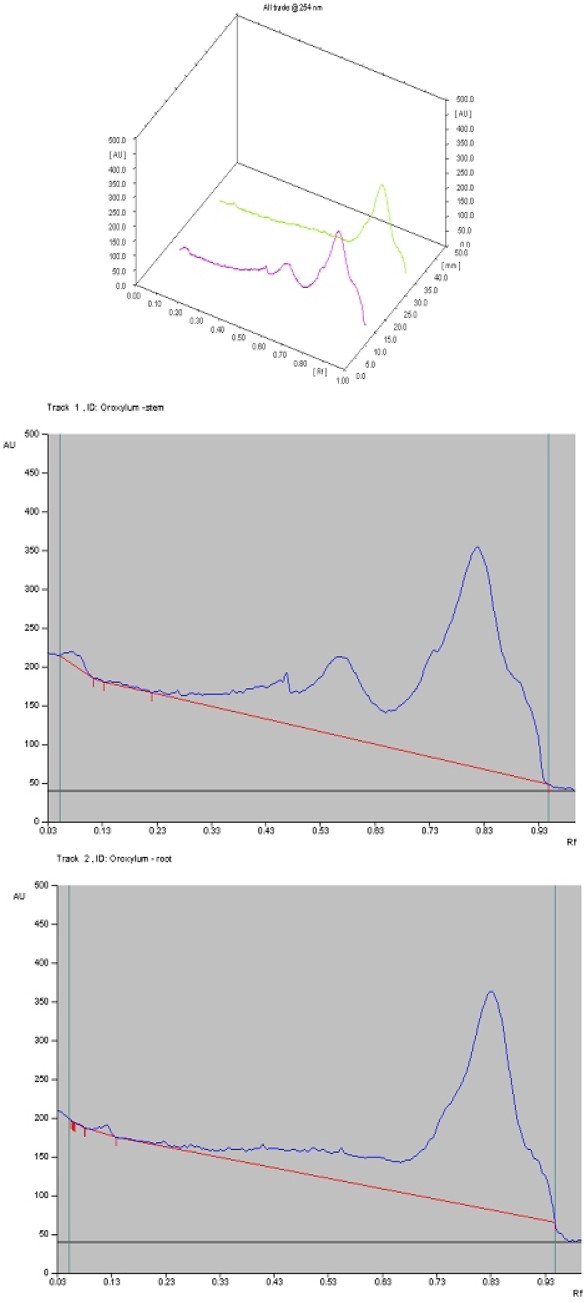
HPTLC studies
Alkaloids separated by general procedure was used for HPTLC study. Solvent system used was Dioxan-Ammonia 9:1. Linear ascending development was carried out and densitometric scanning was performed on CAMAG′s TLC Scanner in absorbance mode at 254 nm.
Root gives 4 peaks of Rf values 0.09, 0.47, 0.57, 0.82. Stem gives 3 peaks of Rf values 0.12, 0.41, 0.83. One additional peak of Rf 0.57 is present in root which is a quick and easy way of distinguishing stem and root.
Antibacterial activity of root and stem of Oroxylum indicum
Antimicrobial activity
For antimicrobial assay, alcohol extract of root and stem of Oroxylum indicum were taken and agar well diffusion method was used. The medium used for antibacterial testing was Muller Hinton agar(MHA). The extracts were dissolved in DMSO(Dimethyl sulphoxide).50 μl of test solution is added to the wells on MHA plate. Gentamycin disc(10 mcg/ disc) for Gram negative bacteria and Ampicillin/Cloxacillin for Gram positive bacteria(10 mcg/ disc and DMSO as negative control were used and incubated at 37°C for overnight. The diameter of zone of inhibition was measured. The antibiotic disc showed high zone of inhibition.
Results and Discussion
The antibacterial activity of alcohol extracts of root and stem was carried out with E.coli, Klebseilla, Proteus, Pseudomonas and S.aureus (Table 1). From the results it is evident that the alcohol extract of stem of Oroxylum indicum showed maximum zone of inhibition against test bacteria ( S.aureus, Klebseilla sps, Pseudomonas aeruginosa whereas alcohol extract of root of Oroxylum indicum showed zone of inhibition only against S.aureus and Proteus sps and all the others were resistant. In the case of Proteus sps the root of Oroxylum indicum showed more zone of inhibition compared to alcohol extract of stem of Oroxylum indicum. Thus it is obvious that alcohol extract of stem of Oroxylum indicum has more antibacterial activity than alcohol extract of root of Oroxylum indicum.

Conclusion
Oroxylum indicum is one of the ingredient of Dasamoolam, the officinal part being the root. Root is often adulterated with stem, and this study of the chemical nature and the antimicrobial action of stem and root would give an insight into the medicinal values of the drug. The parameters studied in this paper can be used to distinguish stem from root and vice versa. Different compounds like alkaloids, phenols, fats, lipids and waxes were separated and separated compounds on TLC analysis showed that the compounds present in the root and stem are different. In the case of anti microbial study, the stem was found to have more antimicrobial effect than root, though root is the officinal part. The difference in antimicrobial activity may be due to the presence of different bioactive components as evidenced by TLC studies.
In Ayurveda also, the actions of stem and root are different. These effects may be attributed to the difference in the chemical constituents of the parts used. Therefore these modern methods give insight into the therapeutic potential of the herbal drugs, and for further development of drugs.14
References
- 1.Prakash Paranjpe., Dr Indian Medicinal Plants. :248–249. [Google Scholar]
- 2.Chopra R.L., Nayar S.L., Chopra L.C. Glossary of Indian Medicinal Plants. :216. [Google Scholar]
- 3.Asima Chatterjee, Satyesh Chandraprakreshi. The Treatise of Indian Medicinal Plants. :300–302. [Google Scholar]
- 4.Rastogi Ram.P., Mehrotta B.N. Compendium of Indian Medicinal Plants. :589–516. [Google Scholar]
- 5.Revised edition. 15 1987. Pharmacopoeial Standards of Ayurvedic Formulations. [Google Scholar]
- 6.Ayurvedic Pharmacopoeia of India. New Delhi, Government of India, Ministry of Health and Family Welfare, Department of Indian System of Medicine and Homeopathy. 1998;3:209, 210. Anonymous. [Google Scholar]
- 7.Sreekantamoorthy K.R., Prof . Varanasi: Krishnadas Academy; 2000. Ashtanga Samgraha of Vaghbata. [Google Scholar]
- 8.Kaviraj Kunjalal., Bhishak Ratna . Varanasi: Susruta Samhitha Chowkambha Orientalia; 1998. [Google Scholar]
- 9.Sarma P.V. Varanasi: Charaka Samhitha Chowkambha Orientalia; 2006. [Google Scholar]
- 10.Thripati, Raja Nighantuh. Varanasi: Chowkambha Orientalia; 1997. [Google Scholar]
- 11.Sreekantamoorthy K.R., Prof . Varanasi: Krishnadas Academy; 1998. Bhavaprakasa Nighantuh. [Google Scholar]
- 12.Sastry J.L.N., Dr. Vol. 2. Varanasi: Chowkambha Orientalia; 2005. Dravyaguna vijnana. [Google Scholar]
- 13.Mackie, Mc Cartney Practical Medical Microbiology. 2:161–180. [Google Scholar]
- 14.Anantha Narayanan. R., C.K.Jayaram Panicker. 7th edition. Orient Longman Publications; 2005. Text Book of Medical Microbiology; pp. 192–322. [Google Scholar]


